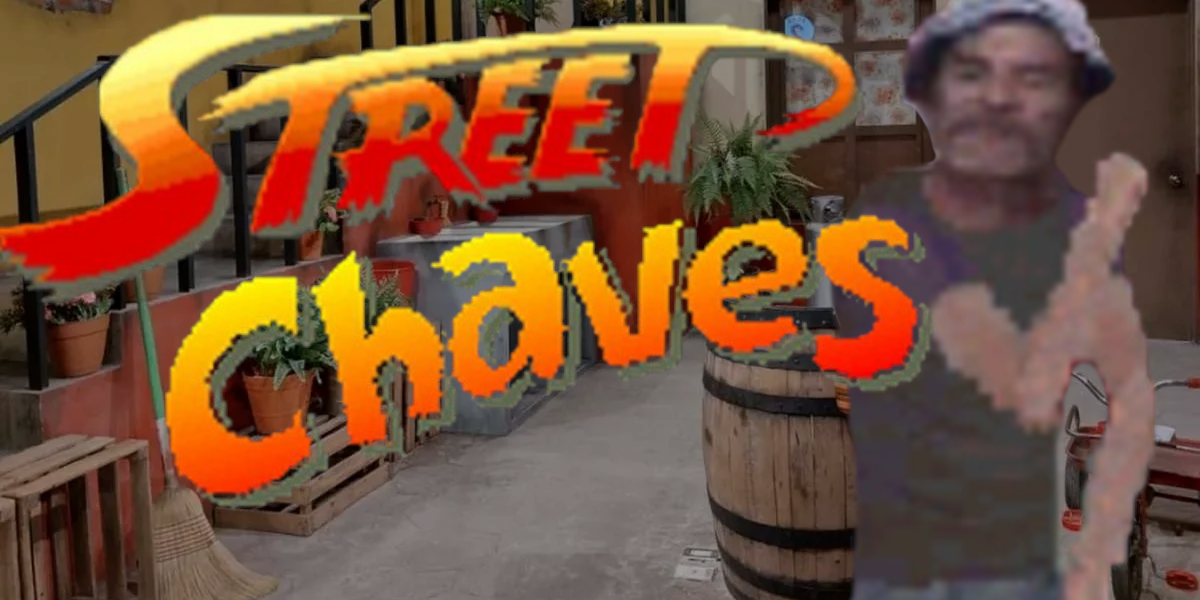
Summary
- Summary
- Preface
- Roberto Gomez Bolaños presents El Chavo del 8
- Street Chaves
- Rabitthole
- Afterword
- References
Preface
Everyone has that one game. That game you discover while looking at someone else screen on computer class as they play a something downloaded from some sketchy site with some characters you know from TV. That game for me is Street Chaves [1], a fighting game based on a popular - if not the most popular - mexican family show about kids, friendship and family. A show from the 70s that's so popular it's apparently still used as an example of national tv licensing expenses [2].
El Chavo del 8 was that lighthearted show my grandma, my dad, that I would watch on Sundays where there was nothing else to do and it was the same for several families in Latin America. It's ingrained into our culture and it's one of the first language cultural exchanges with Mexico I've experience before they dubbed like 90% of all movies/shows/anime. Like what do you mean a "Ham Cake" is a sandwich?
Roberto Gomez Bolaños presents El Chavo del 8
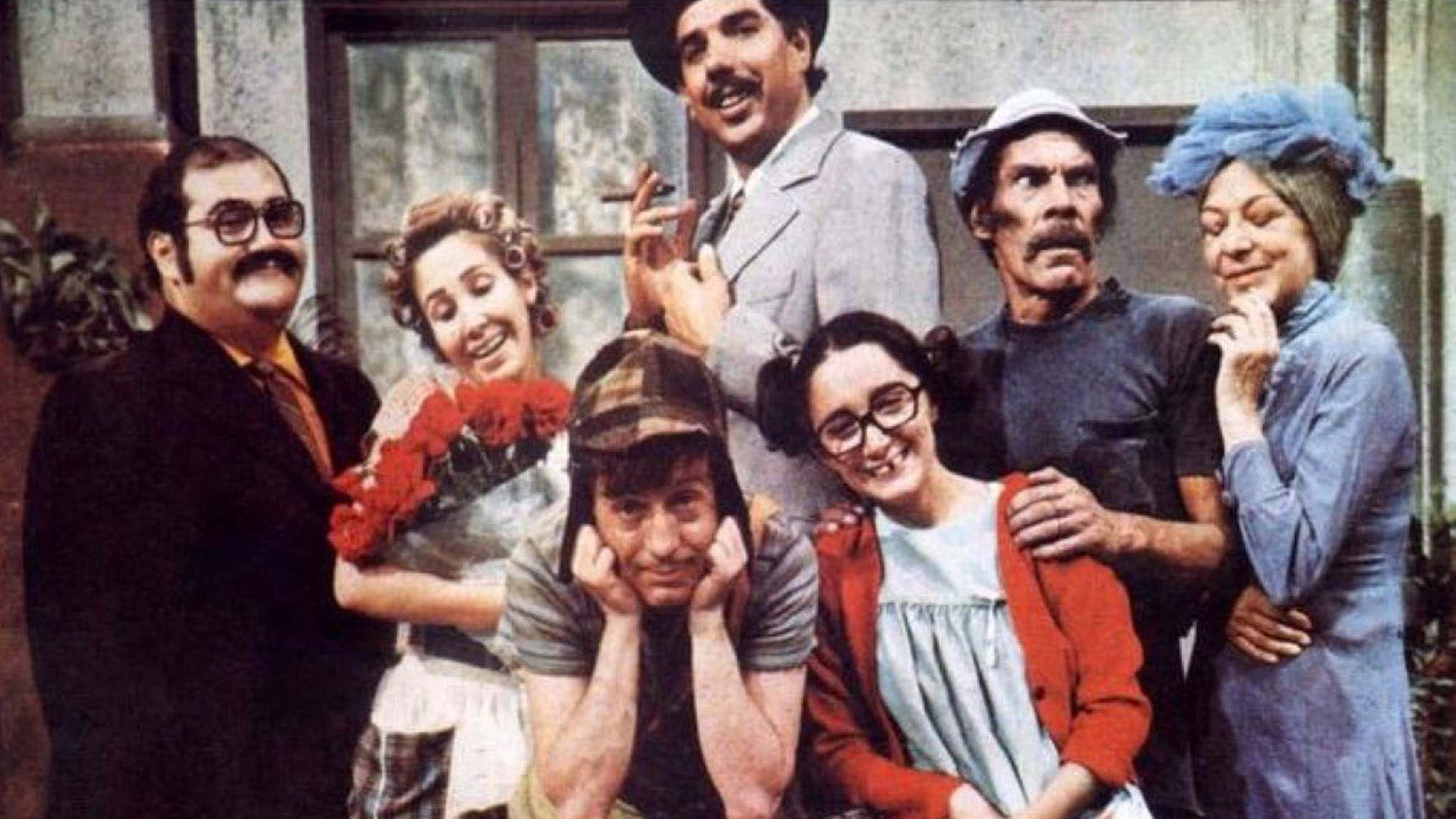
Gomez Bolaños had a lot of experience writing shows when El Chavo and El Chapulín Colorado when from 10 minute sketches to full television shows on their own on '73[3]. The show plot was simple, you would watch the simple life of a middle to low class closed neighborhood residents and how they interact with each other. The jokes would be mostly on the lighter side and most of the "fun" would be carried by the expressiveness of the actors combined with Gomez Bolaños writing.
The recurrent characters, and their brazilian name, are:
- Don Barriga | Senhor Barriga: the landlord of the neighborhood
- Don Ramón | Seu Madruga: A single father that hates working and tries to avoid it at all cost.
- Chilindrina | Chiquinha: Don Ramón's daughter, a bratty and whinny girl.
- Doña Clotilde | Dona Clotilde: An old lady nicknamed "The witch of the 71" by the children.
- Profesor Jirafales | Profesor Girafales: The teacher of the kids in the neighborhood.
- Doña Florinda | Dona Florinda: A widow with a snob and angry attitude.
- Quico | Kiko: Doña Florinda's son. A spoiled child how likes mocking others for being poor and not having the toys he has.
- Chavo | Chaves: A orphan child and the protagonist that gives name to the show.
The show template was simple. The kids would play on the neighborhood, sometimes fighting each other over simple things, and that fight would escalate to Quico, either by accident or on purpose, insulting or hitting Don Ramón. Then Don Ramón would pinch Quico as a punishment, he would cry for his mother only for her to come in, slap Don Ramón in the face and insulting his grandma before leaving. Finally Chavo would make a question about the insult to Don Ramon's grandma and he would hit him as a response. Sure theres some changes to the formula here and there, but the physical comedy was always in the middle of it.
As the actors would come and go from the show due to differences with management, new members were added and taken during the 9 year run that the show had until it finally end in 1980 as a standalone show going back to being a sketch show until 1992. The show did not escape television tho. It was localized to several languages and distributed around the globe being broadcasted on 20 countries by 2011. The combination of lighthearted comedy and a bunch of broken families interacting with each other dealing a good amount of physical violence resonated with people, most of them latin american.
From the dubbed versions of the show, the one that had the most success was the brazilian portuguese one, called Chaves, where the localization team did some serious heavylifting in adapting the show to brazilian audiences. Not only the situations in every episode were localized to places in Brazil but also every song was adapted as well. At the time of writing, the show can be still seen on television[4].
This generated such a fanbase that you could say that they love the show more than their spanish speaking neighbors and no one would bat an eye.
(Theres way, waaaaay more to say about this show but thats for The Rabbithole section)
Street Chaves

It was in 2003 that Street Chaves appeared in the internet. Created by CyberGamba, a brazilian developer that decided to make a fighting game for fun out of his favorite characters from Chaves. The game was made using digitized sprites taken from recordings he made from the show, a technique already used in his game FAINOU FAITI[5] when he put his friends in a beat em up game, programmed in the language Delphi[6]. Three Characters were featured in the 1st alpha of the game: Chaves (the first character created), Seu Madruga and Chiquinha. His friends were so delighted with the game that encouraged him to post the game online as well to make new characters [7].
The full game was released on Geocities[8], and by the time the last update was made, it counted with 15 characters, all of the playing like copies of characters from Fatal Fury/KOF and Street Fighter with the exception of Dona Clotilde that has the moves of Dimitri of Darkstalkers (apt since she is called the witch of the 71).
The modes available after the intro that makes homage to the Street Fighter 2 intro are Story mode and Versus in the same way a normal arcade would work, you "feed" coins into the game and press start with each player for a versus mode. An options menu is available before you put a coin into the game that will allow you to change the difficulty, adjust the volume, flashing lights and round settings as well of a very very broken spanish language mode.
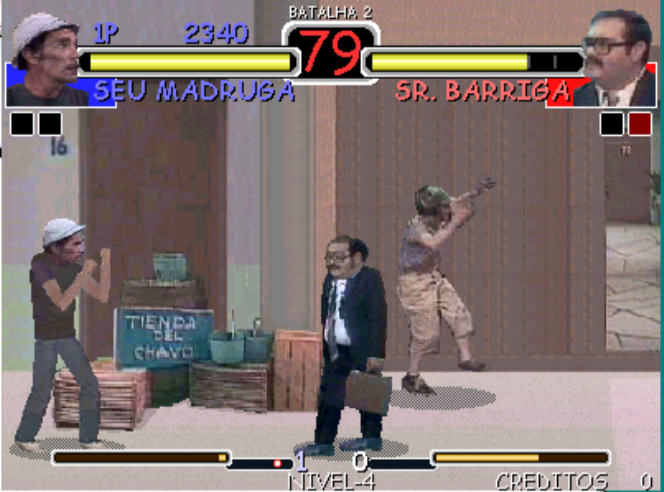
The fight presentation looks mostly like a Kof 94/95 fight (Along with the same 4 button layout), soundtrack taken from songs of the show and backgrounds showing the different characters interacting in a few frames of animation. From time to time Kim Kaphwan would zoom across the state to deliver some Samsho 2 chicken on stage that would give you some life back. Performing a counter on a heavy attack or a super move would flash the screen with an effect, red for the counter and blue with decals for the super move.
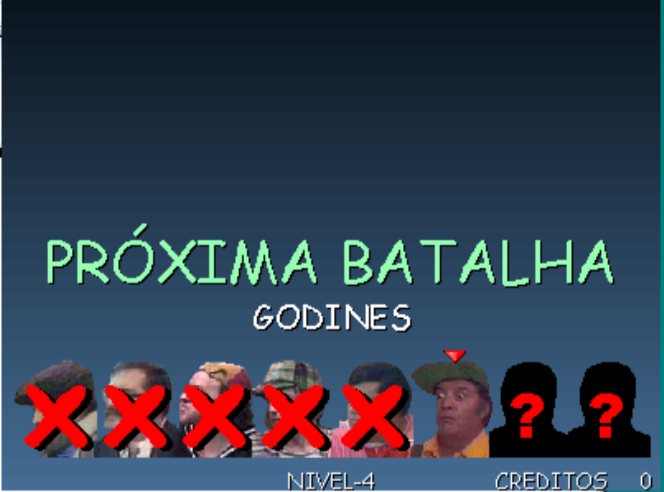
If you decide to try the arcade mode, you will fight 8 characters ending on the rival of your character. If you beat it you will get an ending unique for your character, these are composed of reinterpretation of some the show's episodes, sometimes not even featuring your character.
Here is the full list of characters and the SNK or Capcom counterpart they are based on, in order of appearance on the select screen:
- Chaves: using the moveset of Terry Bogard (Fatal Fury)
- Quico: using the moveset of Andy Bogard (Fatal Fury)
- Seu Madruga: using the moveset of Robert Garcia (Fatal Fury)
- Chiquinha: using the moveset of Yuri Sakasaki (Fatal Fury)
- Dona Florinda: using the moveset of Chun-Li (Street Fighter)
- Profesor Girafales: using the moveset of Sagat (Street Fighter)
- Seu Barriga: using the moveset of Chang Koehan (King of Fighters)
- Bruxa do 71 (Dona Clotilde): using the moveset of Demitri Maximoff (Darkstalkers)
- Paty: using the moveset of Cammy (Street Fighter)
- Nhonho: using the moveset of E. Honda (Street Fighter)
- Godines: using the moveset of Cody (Street Fighter)
- Furtado: using the moveset of Dan Hibiki (Street Fighter)
- Gloria: using the moveset of Mai Shiranui (Fatal Fury)
- Jaiminho: using the moveset of M. Bison/Jp Vega (Street Fighter)
- Dona Neves: using the moveset of Athena Asamiya (King of Fighters)
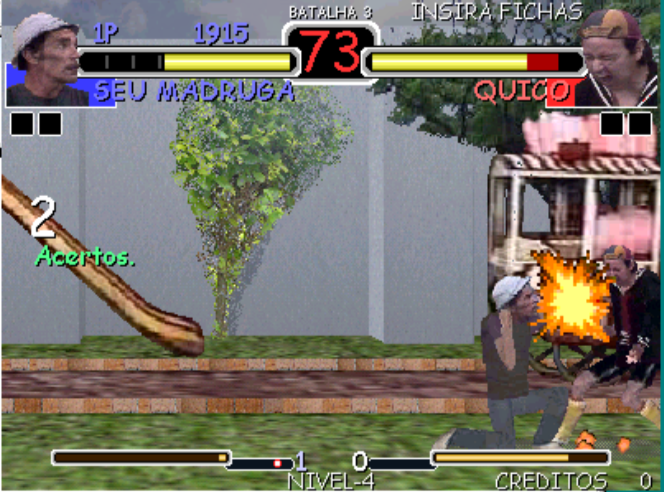
If you wonder how do you balance a game with so many different styled characters, well you don't. Each character is a barebones version of their counterpart, most attacks don't have minus frames so everything that hits during the hitstun state of your enemy will be a combo, this includes Supers, so you can chain them together as they only cost one bar and corner combos TOD are common (if you play against another person).
This unbalanced state, as it happens with many games in the genre, only adds to the fun to the game. It's hectic nature combined with no damage scaling made it a fun game to pass the time with friends as one spams that one move they know while you are trying to land a combo. The South Park-esque presentation of the game combined with the different effect on screens as well as the enemy flying off the stage if you ended the round with a super created a tornado that is still remembered fondly till this day.
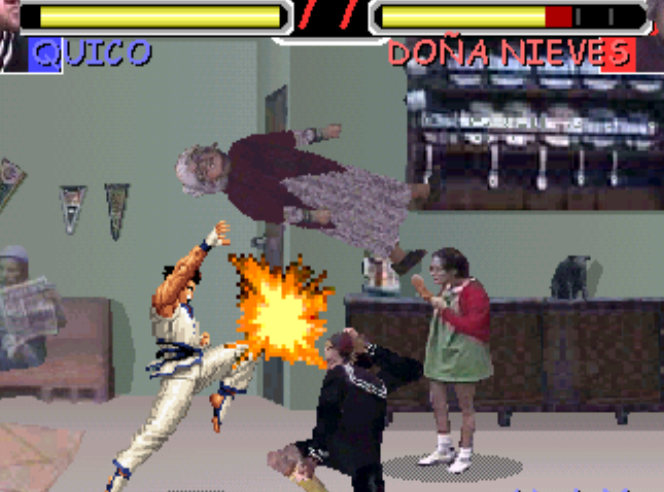
The abandoned Sequel
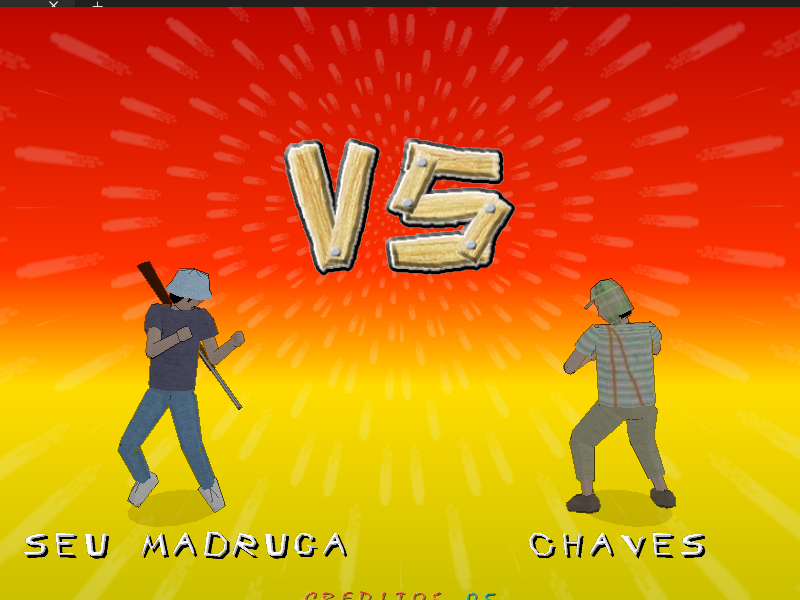
There was a sequel of the game in the works. A 2.5d fighting game with item mechanics (like a bomb or an invisibility potion) and smoother movement. Characters can now have their block broken as well as visible stun bars. You can now spend 2 bars on a special move as well as roll as in modern kof games. The last mechanic is a rush down where you have to press the buttons in certain order to continue an air combo that honestly is really hard to land to begin with.
The prototype available of the game has only 2 characters, Chaves and Seu Madruga (with a rifle), and even tho they still have some borrowed techniques from other games each one of them starts to present an identity of its own.
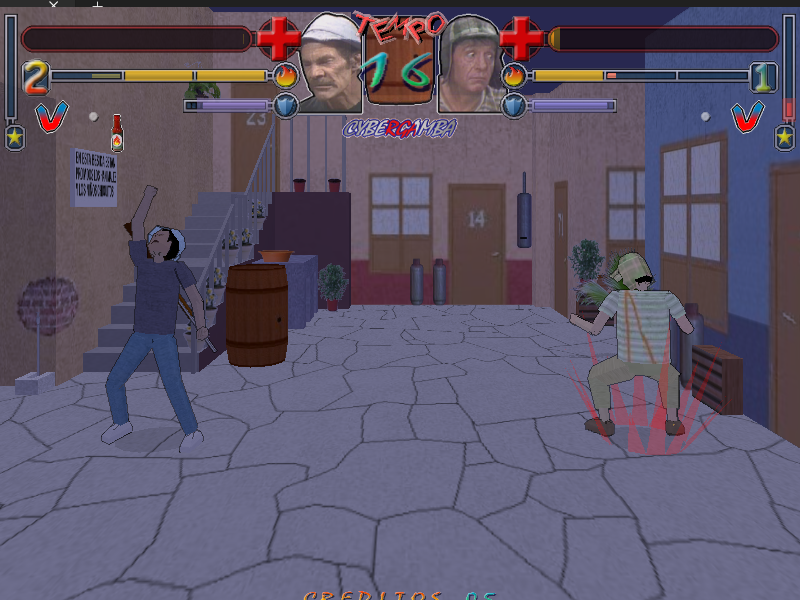
Sadly this project was not continued, as is the nature of most of these fan projects, and we can only guess what the final product would have been like.
The game is still around if you wanna try it out and surprisingly it works well on Windows 11 for me.
The Unofficial "sequel"

A Mega Drive port of the game called "Street Chaves 2" has been in development by Master Linkuei, with the latest update on the project being 3 years ago[[9]]. More than a sequel the 2 in the name is a reference to Street fighter 2.
Most of we can see of the original game is in this port with some compromises, like the characters not having supers or the background being empty.
The most notable addition to the game is the character of Chapolin (Chapolin colorado), the superhero interpreted by Roberto Bolaño in many of his sketches.
Rabitthole
During the research for this game I've learned more than I wanted to know about el Chavo so now you will have to learn as well.
El Chavo after El Chavo
Even if El Chavo del 8 stopped airing new content in it's original form on 1992, it didn't stop grupo chespirito (called after the nickname of Gomez Bolaños) from creating more media related to the characters.
A book called "El diario del Chavo del ocho"[10], The diary of Chavo of the 8, was writer by Gomez Bolaños himself on 1995. A sort of origin story for El Chavo where he narrates how he went from being abandoned by his mother to being fostered by the old lady that used to live on the apartment 8 in the neighborhood as well as his thoughts on the other tenants.
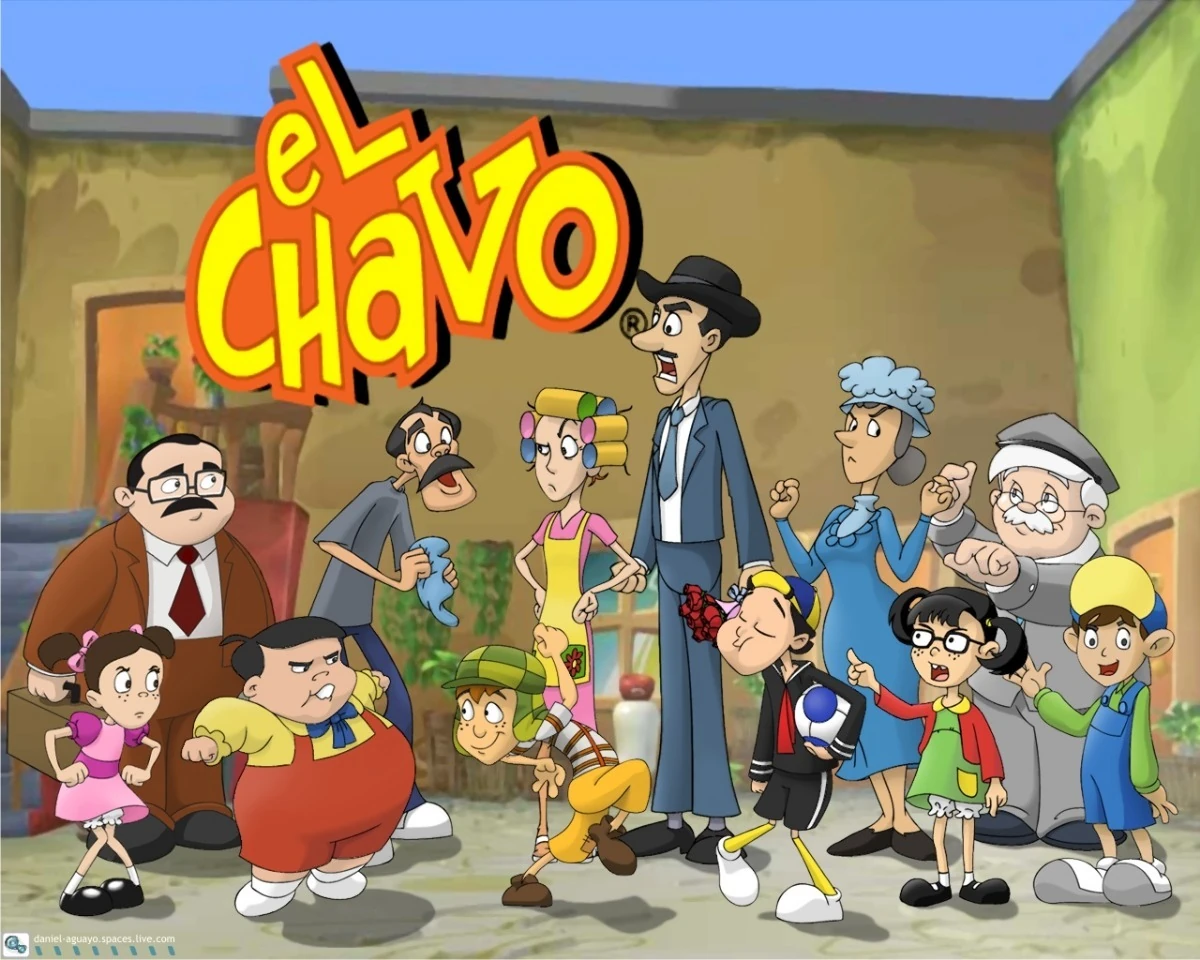
Later in 2006 an animated series was created to retell some of the stories from the original show with some characters missing due to some copyright issues[11]. This series was the basis for a new line of toys and memorabilia based on the cartoon designs.
This, was also the basis for a couple videogames created for mobile phones and consoles being the most notable creation the game El Chavo Kart, a karting game developed by Kaxan Games for PS3 and Xbox 360 on February 2014. This game was announced the year prior on the birthday of Gomez Bolaños[12].
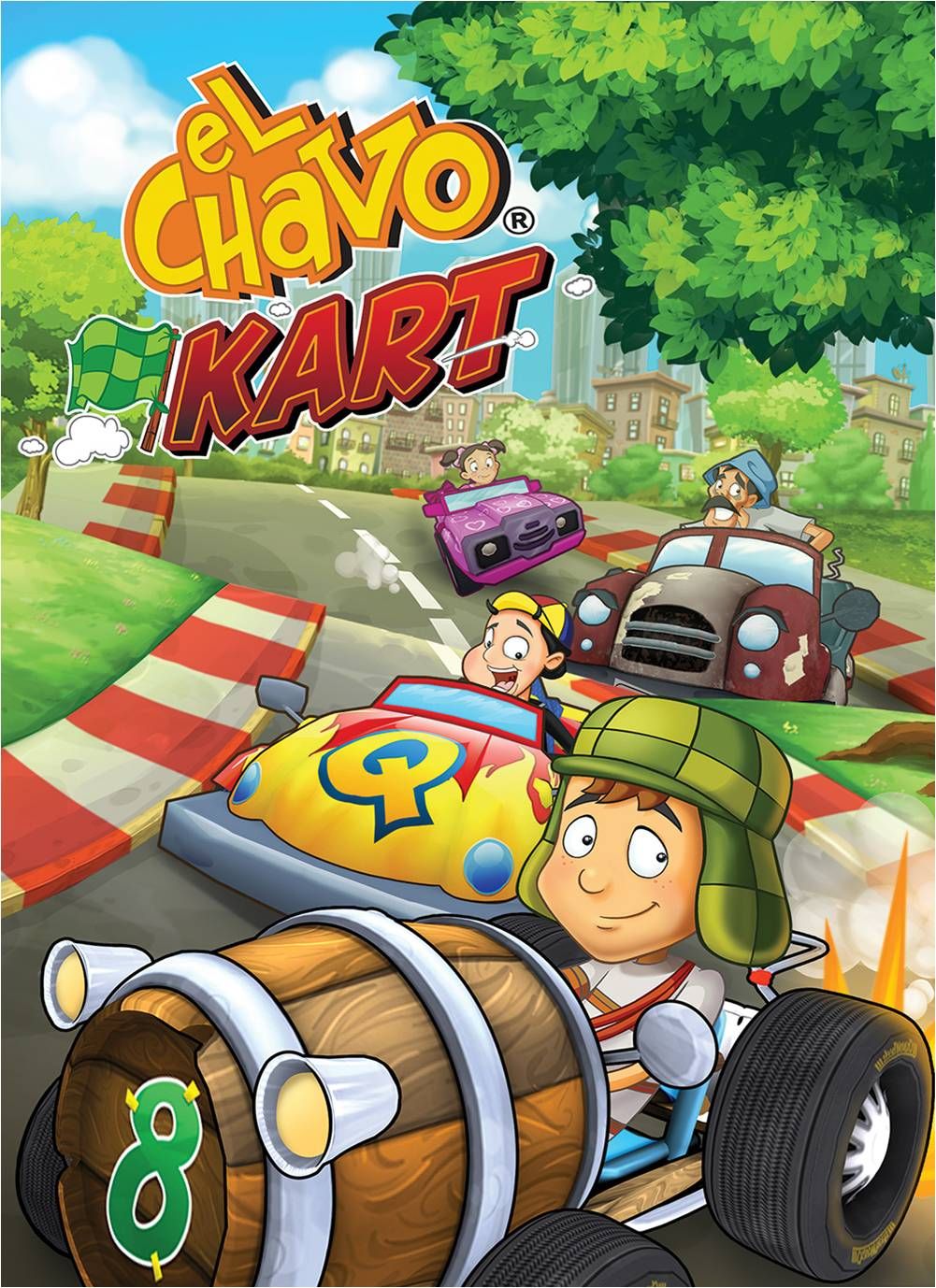
Lastly, on 2025 a short TV series was created called "Chespirito: Sin querer queriendo"[13], a dramatization of the creation and the behind the scenes of the show created by Gomez Bolaños's son Roberto Gómez Fernandez. The early episodes of the series were criticized for making Gómez Bolaños look like a Genius that could come up with everything on the spot but after the series started to show the problems created by his interpersonal relationship ending on the decline of the series. The public eye was glad that they revindicated several figures that were forgotten in the story, like the mother of Gómez Fernandez, Graciela Fernández.
Fascism and propaganda
Neither Gómez Bolaños or El Chavo del 8 existed in a vacuum. Gómez Bolaños was the nephew of Mexican ex president Gustavo Díaz Ordaz Bolaños known for sistematic repression against students leading to the massacre of Tlatelolco in 1968[20], event that had the involvement of the CIA as it was the case with many Latin American countries during the operation condor.
Gomez Bolaños never hid his close relation with the right wing conservative parties, or his love for his uncle and his presidential term[19] , in his words because the "inflation numbers were good". Even until his late life he would appear in propaganda for EL PRI, the right wing christian conservative party.
Even if this kind of politics were never really integrated into the show, a very "we are fine with what we have even if we are poor" kind of beat was permeated in it, creating a light hearted comedy that did not want to change the status quo. And even if we can debate that the comedy was worthy of the fame of the show, this kind of comedy was perfect for the dictatorship around latin america to keep people entertained.
The most notable event tho, was during the latin american tour of the show in 1977 [18] as they landed in Chile during Pinochet's dictatorship. The show had great success. Hundreds of people waited in the airport wanting to show their love for the cast. The problem was that they show they performed was inside of the National Stadium, a place that 4 years prior was used as a concentration camp[14] for prisoners of the political opposition (or anyone they didn't like really).
Goméz Bolaño stated that he didn't knew the history of the place but if he knew he would have gone there anyway.
Love, betrayal and copyright law
If you ever saw El Chavo as a kid you would most likely be aware of the amount of gossip around it. The interpersonal relationship inside the show were complicated to say the least. As the show was getting to the peak of popularity a love pyramid was formed around the actress of Doña Florinda, Florinda Meza.
Quico's actor, Carlos Villagran, Enrique Segoviano, the director of the show, and Gomez Bolaños were at some point romantically involved with Meza, leading to friction between them ending with Villagran and Segoviano leaving the show for good after the relationship of Gómez and Meza started on their trip to Chile.
Meza was, an interesting lady to say the least. She openly stated in an interview with TVN in Chile[15] that Gómez Bolaños has 7 flaws, his wife and children and when asked about her relationship with Villagran she stated that he is and asshole and she doesn't date assholes[16]. It also rumored that she was the reason for Ramón Valdes, the actor of Don Ramon, to leave the show as she was starting to take ownership of the show and take to a place he wasn't comfortable with.
After leaving the show, Villagran didn't want to leave the character of El Quico behind so he created El Quiko, stating that most of what made the character was his and not Gómez Bolaños's writing. He started a show with Ramon Valdes in Venezuela to moderate to low success and would make shows around latam with the character.
On the other hand, the actress of Chilindrina, María Antonieta de las Nieves, had a close relationship with Gómez Bolaños and asked him to use the character after the show ended which he responded "as long as I'm in the credits". It was later in 1994, that de las Nieves discovered that the intellectual property of the Chilindrina had not been rewed during 15 years so she decided to register the IP under her name so she could do whatever she wanted with it[17]. This severed the relationship between Gómez and her until the day he died.
A cult to Don Ramón

Among all the characters in the show no one sprung such a cult following like Don Ramón. Ramón was the only person in the neighborhood that was not happy with the status quo of society, he was a single father that hated working and, in the few moments he got a job to pay rent of to help his daughter, he would take it as a disaster. Even without a job he would laugh, and play with the children and educate his daughter, creating the idea, for me, that man can be dignified without a job.
His paternal figure didn't not existed only on the TV. Ramón Valdes was a man that lived job to job to get enough for him, his wife and 7 children to go by. His own son stated that he would carry a picture of all of them and an extra one of María De las Nieves, to which he would consider his daughter even outside of the role they interpreted on screen.
This sweet image of a loving father and working class hero contrasted to the love affair chaos on the other side of the show gave him an status of idol to the point it was the face I see the most in t-shirts on the street as a kid along side with Che Guevara.
Afterword
Honestly I didn't believe that this little project that I wanted to make showing some of the games I like would take me nearly a year to finish. But the story of this show is so ingrained into the culture of latin america that even if you don't like it's hard to not be awared of it.
This game does not exists in a vacuum and even if I'm a little sad that the game section of this write up is shorter than the drama one it's proper context to understand not only how things are made but why are they important through time.
Street Chaves is a game so lost in it's own mythology that most of the people I've met still belive that this is a MUGEN game, maybe because the brazilian MUGEN Scene is also huge, or some of the thinking that the "good" characters of the show are snk character and the "bad" ones are Street Fighter because CyberGamba hated Capcom even tho there's no information that can back that up.
This is not a perfect piece of work and I had to create pieces of software to actually be able to capture the game consistently but it's here now, and I can write about something else.
References
- RetroArkade: Já faz dez anos que jogamos Street Chaves, o “melhor” jogo do Chaves de todos os tempos!
- Evelin Mathei propone reducir TVN al mínimo
- El Chavo Del Ocho - La historia detrás del mito (TV Azteca)
- Chaves retorna ao horário nobre como maior audiência do SBT
- Fainou Faiti - Vilelas edition
- Delphi Homepage
- CYBERGAMBA: O PAI DO STREET CHAVES
- Geocities crieseusjogos
- Entrevista com os criadores de Street Chaves II para Mega Drive
- Comercial Del Diario Del Chavo Del 8 (1995)
- Filmaffinity: El chavo animado
- Celebran cumpleaños de Chespirito con lanzamiento de 'El Chavo Kart'
- HBO Max anuncia série sobre a vida de Roberto Bolaños, o Chaves
- Estadio Nacional, Memoria Nacional – Chile
- Entrevista completa de Chespirito y Florinda Meza: "Él tenía siete grandes defectos" | TVN Chile
- Florinda Meza revela la verdad de su relación con Kiko | Saga Live
- MARÍA ANTONIETA DE LAS NIEVES: la eterna niña de la televisión mexicana | Pati Chapoy
- El Chavo del 8: la historia oculta de su visita a Chile
- ¿’Chespirito’ era sobrino del expresidente Gustavo Díaz Ordaz, por qué no se menciona en la serie?
- Generations of students remember 1968 massacre in march through Mexico City
 Home
Home Blog
Blog Gaming
Gaming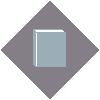 reading
reading Fav Stuff
Fav Stuff About
About

